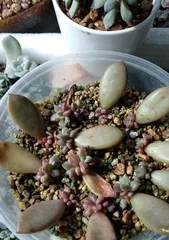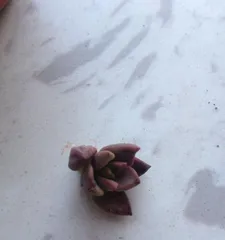Graptopetalum paraguayense is a common potted plant, beloved for its beautiful leaves and unique shape. However, many people make mistakes when caring for it, leading to problems such as slow growth and yellowing leaves. This article will cover two aspects of Graptopetalum paraguayense care: potting and maintenance, to provide a detailed introduction on how to properly care for it.

Why is repotting necessary?
Repotting is a necessary step in the growth of Graptopetalum paraguayense. When the plant outgrows its original pot, its roots will start to spread out. At this point, it needs to be moved to a larger pot to provide it with a more spacious growing environment.
When should you repot?
Graptopetalum paraguayense should be repotted once a year, preferably in spring. Specifically, choose a warm and humid day, which will help the plant quickly adapt to its new growing environment.

Choosing the right potting soil
Choosing the right potting soil is crucial for the growth of Graptopetalum paraguayense. The soil should be loose, well-draining, and rich in nutrients. Generally, a mixed potting soil composed of materials such as leaf mold, sand, and peat can be used.
How to repot correctly?
Remove the plant from the old pot and rinse the roots clean with water. Next, place the Graptopetalum paraguayense into the new pot and spread a layer of compost at the bottom. Fill the pot with new soil and gently press it down with your hands.
How to water?
Graptopetalum paraguayense needs to be watered once a week, but the amount of water should be appropriate and not excessive. Before watering, make sure the soil is completely dry to ensure the roots are not submerged by too much water.

How to fertilize?
Graptopetalum paraguayense needs to be fertilized once every two weeks, using an appropriate amount of plant nutrient solution. Be careful not to over-fertilize, as this can damage its roots.
How to prevent pests?
Graptopetalum paraguayense is susceptible to pests such as aphids and spider mites, so it is necessary to check regularly and take corresponding measures. You can use insecticides or wipe the leaves with soapy water to prevent pests.
How to prune?
Graptopetalum paraguayense needs to be pruned once a year, trimming off overly long or withered leaves to maintain its aesthetic appeal. Use clean pruning tools and provide the plant with sufficient nutrients after pruning.
How to prevent yellowing leaves?
If the leaves of Graptopetalum paraguayense turn yellow, it may be due to improper care. In this case, you need to check the watering and fertilization, ensure it has sufficient nutrients, and pay attention to sunlight and ventilation.
How to prevent leaf tips from drying out?
Dried leaf tips are a common problem for Graptopetalum paraguayense, usually caused by dry air. Therefore, you can place a humidity regulator nearby or put the pot in a semi-shaded location to increase the ambient humidity.
How to avoid growing too tall?
If Graptopetalum paraguayense grows too tall, you can appropriately prune its top and increase watering and fertilization after pruning to promote branching growth and maintain its appearance.
How to prevent leaves from turning black?
If the leaves of Graptopetalum paraguayense turn black, it may be due to overwatering. In this case, you need to reduce the amount of watering and ensure the soil maintains moderate moisture.
How to control the growth rate?
If Graptopetalum paraguayense grows too fast, you can appropriately reduce the frequency of fertilizing and watering to control its growth rate. At the same time, pay attention to the sunlight and ventilation to maintain a stable environment.
How to prevent wilting?
If Graptopetalum paraguayense shows signs of wilting, it may be due to insufficient water in the soil. In this case, you need to increase watering to ensure it has sufficient water supply, while avoiding overwatering.
Repotting and maintenance are crucial for the healthy growth of Graptopetalum paraguayense and require our daily attention. Through proper repotting and maintenance methods, we can ensure Graptopetalum paraguayense grows healthily and brings us more beauty and joy.